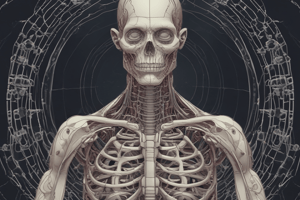Podcast
Questions and Answers
What is the primary focus of gross anatomy?
What is the primary focus of gross anatomy?
- Study of structures at the cellular level
- Study of metabolic processes in cells
- Study of structures visible to the naked eye (correct)
- Study of anatomical changes throughout life
Which level of organization represents the basic unit of life?
Which level of organization represents the basic unit of life?
- Tissue Level
- Cellular Level (correct)
- Organ Level
- Chemical Level
What does pathophysiology study?
What does pathophysiology study?
- Homeostasis and feedback mechanisms
- Functions of individual cells
- Disordered physiological processes associated with disease (correct)
- Normal physiological processes of the body
Which feedback mechanism enhances changes in the body?
Which feedback mechanism enhances changes in the body?
What is emphasized by the statement 'structure determines function'?
What is emphasized by the statement 'structure determines function'?
Which branch of physiology studies the functions of specific organs?
Which branch of physiology studies the functions of specific organs?
What are the major processes included in metabolism?
What are the major processes included in metabolism?
What is considered the highest level of organization in the body?
What is considered the highest level of organization in the body?
Flashcards are hidden until you start studying
Study Notes
Anatomy
-
Definition: Study of the structure of the body and its parts.
-
Branches:
- Gross Anatomy: Study of structures visible to the naked eye (e.g., organs, systems).
- Microscopic Anatomy: Study of structures at the cellular level (e.g., histology).
- Developmental Anatomy: Study of anatomical changes throughout life (e.g., embryology).
-
Body Organization:
- Levels of Organization:
- Chemical Level: Atoms and molecules (e.g., DNA, proteins).
- Cellular Level: Cells as the basic unit of life.
- Tissue Level: Groups of similar cells performing a common function (e.g., epithelial, connective, muscle, nervous tissues).
- Organ Level: Structures composed of two or more tissue types (e.g., heart, liver).
- System Level: Groups of organs that work together (e.g., cardiovascular system).
- Organism Level: Whole living being.
- Levels of Organization:
Physiology
-
Definition: Study of the functions and mechanisms of the body and its parts.
-
Branches:
- Cell Physiology: Study of cell functions (e.g., metabolism, signaling).
- Organ Physiology: Functions of specific organs (e.g., cardiac physiology).
- Systemic Physiology: Functions of systems (e.g., respiratory physiology).
- Pathophysiology: Study of disordered physiological processes associated with disease.
-
Key Concepts:
- Homeostasis: Maintenance of stable internal conditions (e.g., temperature, pH).
- Feedback Mechanisms:
- Negative Feedback: Mechanisms that counteract changes (e.g., body temperature regulation).
- Positive Feedback: Mechanisms that enhance changes (e.g., blood clotting).
- Metabolism: Chemical processes that maintain life, including anabolism (building up) and catabolism (breaking down).
Interaction of Anatomy and Physiology
- Structure Determines Function: The shape and structure of a body part influence how it works (e.g., the heart's structure supports its function of pumping blood).
- Integrative Approach: Understanding how anatomical structures relate to physiological functions is crucial for fields like medicine, biology, and health sciences.
Anatomy
- Study of the body's structure and its components.
- Branches:
- Gross Anatomy: Examines structures visible without a microscope, including organs and systems.
- Microscopic Anatomy: Focuses on cellular structures, utilizing techniques like histology.
- Developmental Anatomy: Explores changes in anatomy from conception through adulthood, emphasizing embryology.
Body Organization
- Levels of Organization:
- Chemical Level: Consists of molecules and atoms, foundational for biological functions (e.g., DNA, proteins).
- Cellular Level: Basic unit of life where cells perform specific functions.
- Tissue Level: Groups of similar cells performing a unified role, categorized into types like epithelial, connective, muscle, and nervous tissues.
- Organ Level: Composed of multiple tissue types functioning together (e.g., heart, liver).
- System Level: Collections of organs working synergistically (e.g., cardiovascular system).
- Organism Level: Represents the complete living entity.
Physiology
- Study of the functions and processes of the body and its systems.
- Branches:
- Cell Physiology: Investigates cell functions, such as metabolism and signaling pathways.
- Organ Physiology: Focuses on specific organ functions, illustrating systems like cardiac physiology.
- Systemic Physiology: Analyzes the functions of various organ systems, exemplified by respiratory physiology.
- Pathophysiology: Studies abnormal physiological processes tied to diseases and disorders.
Key Concepts
- Homeostasis: The process of maintaining stable internal conditions (e.g., temperature and pH levels) for optimal functionality.
- Feedback Mechanisms:
- Negative Feedback: Mechanisms that counteract changes and help return the body to a set point (e.g., thermoregulation).
- Positive Feedback: Mechanisms that amplify changes leading to a specific outcome (e.g., blood clotting during injury).
- Metabolism: Encompasses all chemical processes necessary for sustaining life, involving two main pathways:
- Anabolism: The building-up processes.
- Catabolism: The breakdown processes.
Interaction of Anatomy and Physiology
- Structure Determines Function: The anatomical design of a structure, like the heart, is tailored to support its functional role in circulation.
- Integrative Approach: Understanding the connection between anatomy and physiology is vital across medical, biological, and health sciences fields.
Studying That Suits You
Use AI to generate personalized quizzes and flashcards to suit your learning preferences.




